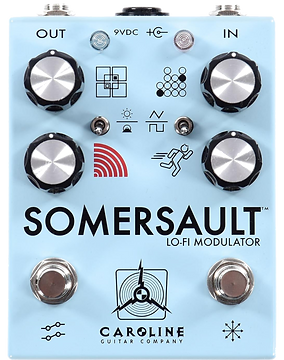

In a market saturated with remakes, clones, and “re-imagined” vintage Fuzz tones, The Pelt™️ (an original Fender design) is a bit of a standout.
In this exercise, I dug into ways to make version 2.0 of The Pelt a pedalboard must-have for the gigging guitarist.
PROS
LEDs on the Knobs. Often, pedal knobs and labels can't be read onstage. The Pelt brilliantly has LEDs on the knobs.
Bloom knob. This knob adjusts the texture of the fuzz, and it's unique to The Pelt. This effectively "drives the ship" and creates the most tonal variety.



CONS
Heirarchy of Controls. There are 4 knobs and two toggle switches, but these are not of equal importance and anything beyond the 3-knob standard needs to justify it's complexity.
Aesthetics and "Cool" factor. A frequent complaint about the Fender line is that it looks sterile and uninspired. Why didn't fender leverage their iconic style?
Interface-Lift
1. - Tone knob switched to a toggle.
Fuzz pedal users typically find one or two “sweet spots” on this dial, So the toggle simply represents those spots.
2. - Heirarchy of knobs.
The Bloom knob is what makes this pedal unique, and what has the greatest impact on dialing in tone. Making this knob bigger indicates to a user the greater importance of adjusting this knob.

Version A
3. - Mid-Boost indicator LED
Small LED indicator to the dedicated Mid-Boost footswitch. This is separate, independent switch from the On/Off indictor.
4. - Expression pedal jack for further hands-free adjustment
An expression pedal jack is added, which can control the parameters for one of knobs (Level, Fuzz, Bloom). User can Select which knob is assigned to the footswitch.

Version B
5. - Mid-Boost is Footswitchable
Since mid-boosting a fuzz is a critical adjustment in a live context, the adjustment can be made hands-free.
6. - Classic Fender Styling
Most users admit that looks are very important, even for an effects pedal. To leverage some of the iconic Fender style, the logo and bloom knob resemble the faceplate layout and font of a “Silverface” style amplifier.

Further Tweaks
VIP Settings / dead-simple adjustment
There is no baseline, or “try these first” anywhere in the manual. If we take it one step further, let’s make the pedals dead-simple out of the box, no manuals needed. Use “All knobs at noon” as a VIP setting, and tweak left or right from there. The Caroline Guitar Company’s Somersault pedal uses this concept, referring to a preferred setting as “True North”. This is brilliant.








Leveraging Brand Identity
Guitarists say the current design look sterile, and lacks the iconic style that comes with the Fender lineage. It looks like a Strymon, not a Fender.
Colors
Why not use iconic colors? Olympic White, Shell Pink, Sonic Blue, Fiesta Red, Butterscotch Blonde -- These are immortal colors. Leverage that.
Knobs
The LEDs are cool, but could we incorporate that into the traditional Fender amplifier knobs?
Relic and Mojo
Guitarists love Fender guitars -- especially used, beat-up, and worn-down Fenders. They have character and a “mojo” that comes with a well-loved instrument. Why not leverage that road-worn character?
Custom Shop & Masterbuilt Pedals
Guitar players will pay an astronomical premium for hand-built, custom guitars... Why not pedals? Offer special finishes like wood enclosures and brushed nickel hardware.




